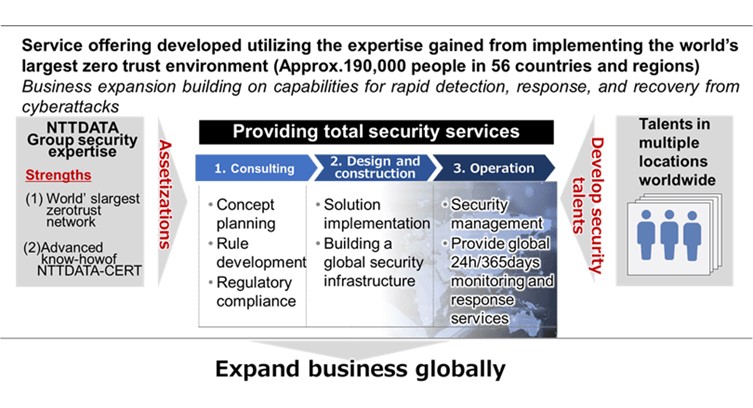NTT DATA, a global digital business and IT services leader, today announces the launch of an outsourcing service for security management (Mservice1) to prevent incidents and minimize damage when incidents occur.
The service will be first provided in Japan from July 2023, and expanded to worldwide within the fiscal year (ending March 2024). With the Mservice, advanced security engineers who have more than 20 years of experience with incident response as part of the company's CSIRT2 organization, as well as expertise accumulated through the Zero Trust Security Service that NTT DATA provides worldwide will provide supports to client companies.
In an incident, NTT DATA engineers will act on behalf of client companies, executing a comprehensive set of measures to identify the cause, implement emergency response measures, maximize recovery efforts, and prevent recurrence.
At the same time, to develop talents to handle Mservices, NTT DATA will launch a talent development program for advanced security engineers, with the aim of expanding the structure from the current level of 100 persons to about 500 persons globally by the end of March 2026.
Going forward, NTT DATA aims to reach annual global sales from security management of over 200 billion Japanese yen by the end of March 2026, mainly in zero trust services.
Background
Changes in the business environment such as overseas expansion, widespread adoption of remote work, diversification of supply chains, and the recent rapid progress of AI, have made it difficult to defend fully against increasingly sophisticated and complex cyberattacks. On the premise that incidents will occur, emphasis is placed on detection, response, and restoration as soon as possible to minimize damage. As a result, demand is rising for security management to not only detect incidents, but to manage response and recovery operations.
At the same time, a significant number of companies find it difficult to manage security on their own due to the considerable effort required, as well as the high level of specialized knowledge needed to respond quickly and appropriately. NTT DATA has long regarded increasingly sophisticated and complex cyberattacks as a management risk, and has strengthened its security governance globally, including introducing a zero trust environment for all NTT DATA Group employees in 2020. This environment is currently being utilized by approximately 190,000 employees in 56 countries and regions. Further, in 2021, NTT DATA began utilizing the know-how gained from this initiative to offer a similar service worldwide as the Global Zero Trust Security Service.
Overview of the MService
To support client companies that find it difficult to manage security on their own, NTT DATA will start providing Mservices utilizing the design, construction, and operational know-how cultivated through its Global Zero Trust Security Service, along with the experience for more than 20 years and expertise of NTTDATA-CERT, its advanced security specialist organization.
This service provides client companies with locations in Japan and other countries with fully integrated, cross-sectional, and multilingual support, from the introduction of an incident response framework to detection, response, and recovery in an incident, as well as continual evaluation and improvement of the introduced framework.




















